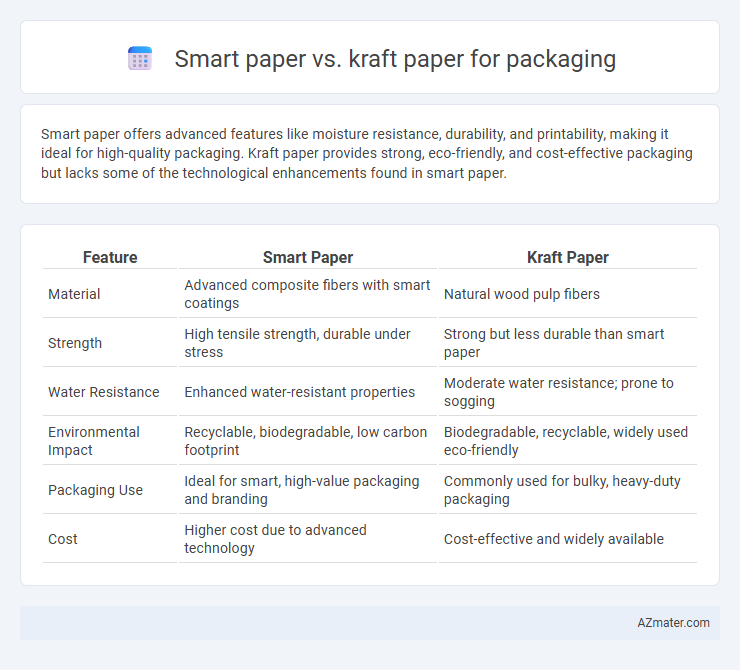Smart paper offers advanced features like moisture resistance, durability, and printability, making it ideal for high-quality packaging. Kraft paper provides strong, eco-friendly, and cost-effective packaging but lacks some of the technological enhancements found in smart paper.
Table of Comparison
| Feature | Smart Paper | Kraft Paper |
|---|---|---|
| Material | Advanced composite fibers with smart coatings | Natural wood pulp fibers |
| Strength | High tensile strength, durable under stress | Strong but less durable than smart paper |
| Water Resistance | Enhanced water-resistant properties | Moderate water resistance; prone to sogging |
| Environmental Impact | Recyclable, biodegradable, low carbon footprint | Biodegradable, recyclable, widely used eco-friendly |
| Packaging Use | Ideal for smart, high-value packaging and branding | Commonly used for bulky, heavy-duty packaging |
| Cost | Higher cost due to advanced technology | Cost-effective and widely available |
Introduction to Smart Paper and Kraft Paper
Smart paper integrates advanced technologies such as sensors and conductive inks to enhance packaging functionality by enabling features like real-time tracking and freshness monitoring. Kraft paper, derived from wood pulp through the kraft process, is renowned for its durability, high tear resistance, and eco-friendliness, making it a staple in sustainable packaging solutions. Both materials serve distinct roles in packaging, with smart paper offering interactive capabilities and kraft paper providing robust protection and recyclability.
Key Differences Between Smart Paper and Kraft Paper
Smart paper integrates embedded technology such as RFID chips or QR codes for enhanced tracking and data management, whereas Kraft paper is a traditional, durable material known for its high tear resistance and eco-friendliness in packaging. Smart paper offers interactive capabilities and digital connectivity, ideal for supply chain optimization and anti-counterfeit measures, while Kraft paper excels in cost-effectiveness and recyclability. The key differences lie in their functionality--smart paper emphasizes technological integration, and Kraft paper focuses on strength and sustainability.
Composition and Manufacturing Process
Smart paper for packaging is typically engineered with advanced coatings such as biodegradable polymers or embedded sensors, enhancing durability and functionality, while kraft paper is made from wood pulp processed through the kraft chemical pulping method, resulting in a strong, coarse material ideal for heavy-duty applications. The manufacturing process of smart paper involves adding nano-materials or responsive inks during production, enabling features like moisture resistance or QR code integration, whereas kraft paper undergoes washing and bleaching sequences to produce a tough fibrous texture. Both materials serve distinct packaging needs based on their structural composition and tailored manufacturing technologies.
Environmental Impact and Sustainability
Smart paper packaging, often featuring biodegradable coatings and embedded sensors, reduces environmental impact by enhancing recyclability and minimizing waste through improved product tracking. Kraft paper, made from natural wood pulp without added chemicals, is highly sustainable due to its renewable source and ease of recycling or composting, contributing significantly to lower carbon emissions. Choosing between smart paper and kraft paper depends on balancing the benefits of advanced functionality with the intrinsic ecological advantages of traditional kraft paper in packaging applications.
Strength and Durability Comparison
Smart paper exhibits superior strength and durability compared to kraft paper, owing to its advanced fiber bonding technology and enhanced material composition. Kraft paper, made from wood pulp with longer fibers, offers respectable tear resistance but tends to be less resistant to moisture and heavy loads than smart paper. The enhanced tensile strength and abrasion resistance of smart paper make it a more reliable choice for heavy-duty packaging applications requiring prolonged protection and impact resistance.
Cost Efficiency for Packaging Solutions
Smart paper offers higher cost efficiency for packaging solutions by reducing material usage through its lightweight and durable properties, which lowers shipping expenses. Kraft paper provides a budget-friendly option with excellent strength, but its heavier weight can increase transportation costs. Selecting smart paper minimizes total packaging expenses by optimizing both material and freight costs.
Printability and Customization Options
Smart paper offers superior printability with high-resolution ink compatibility and vibrant color reproduction, making it ideal for detailed branding and marketing materials. Kraft paper provides a natural, rustic appearance with limited print quality, mainly supporting basic logos and text in monochrome or simple colors. Customization options on smart paper include various finishes, coatings, and textures to enhance visual appeal, while kraft paper customization typically centers on embossing, stamping, or eco-friendly inks to maintain its organic aesthetic.
Applications in Modern Packaging Industry
Smart paper integrates sensors and conductive materials, enabling real-time tracking and interactive features that enhance product authentication and supply chain transparency. Kraft paper, known for its strength, durability, and eco-friendliness, remains widely used for heavy-duty packaging, offering robust protection for shipping and storage. In the modern packaging industry, smart paper is favored for high-tech consumer goods requiring advanced monitoring, while kraft paper is preferred for sustainable, cost-effective solutions in bulk and industrial packaging.
Consumer Preferences and Market Trends
Smart paper packaging gains popularity for its advanced features like moisture resistance and printability, appealing to eco-conscious consumers seeking innovation and sustainability. Kraft paper remains favored for its natural appearance, durability, and recyclability, aligning with market trends emphasizing minimal environmental impact and cost-effectiveness. Consumer preferences increasingly drive the packaging industry towards hybrid solutions that combine the robustness of kraft paper with smart paper's functional enhancements.
Choosing the Right Paper for Your Packaging Needs
Choosing the right packaging paper involves evaluating the durability, sustainability, and print quality of smart paper versus kraft paper. Smart paper offers advanced features like embedded sensors and enhanced moisture resistance, ideal for high-tech or premium packaging solutions. Kraft paper excels in strength, recyclability, and cost-effectiveness, making it suitable for eco-friendly and heavy-duty packaging applications.

Infographic: Smart paper vs Kraft paper for Packaging
 azmater.com
azmater.com